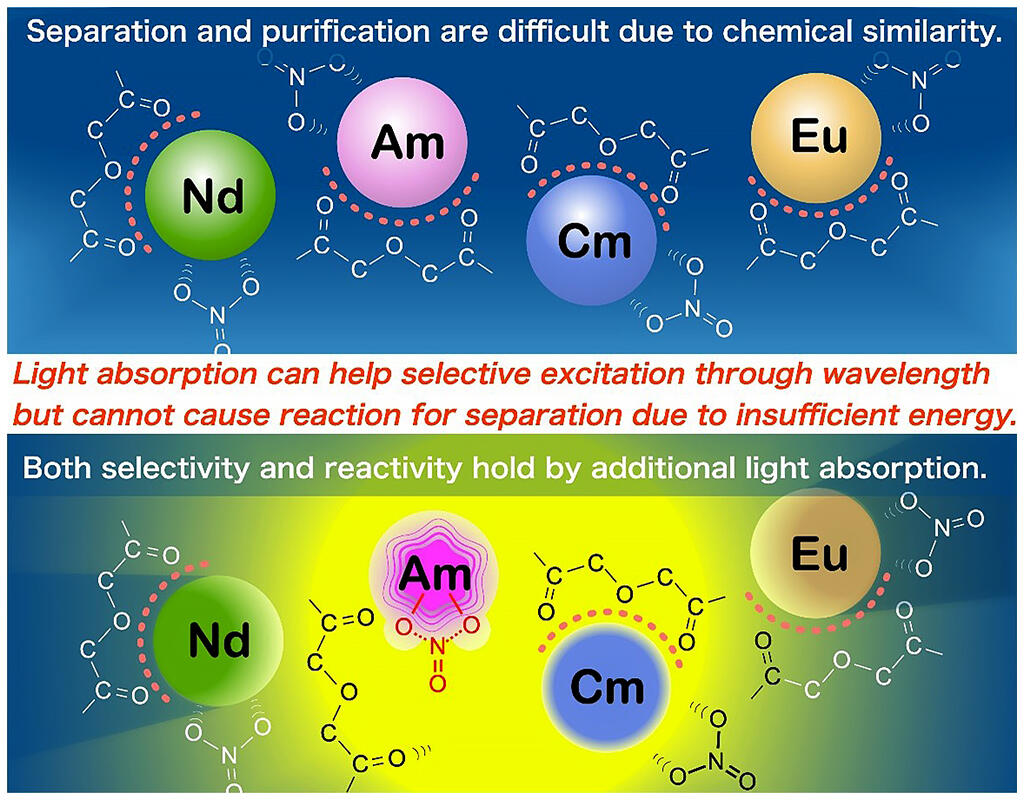A research group comprised of postdoctoral researcher Shohei Matsuda and senior researcher Keiichi Yokoyama of the Actinide Chemistry Group, Materials Sciences Research Center, Japan Atomic Energy Agency (JAEA), and Professor Emeritus Nobuaki Nakashima of Osaka Metropolitan University, have found that they can elicit oxidation in americium within a nitric acid solution by irradiating it with a special absorption wavelength laser, allowing for the successful performance of a separation experiment with americium.

In order to reduce the impact from geologic disposal of radioactive waste, it is important to seperate the highly hazardous long-term radioactive elements (especially americium) from the radioactive waste. Groups of elements called actinides and lanthanides in spent fuel have similar chemical properties because, in the same oxidation state, they have the same arrangement of electrons in the outermost shell of the atom and are almost identical in size. Therefore, separation of these elements by chemical means is challenging. Meanwhile, unlike the outermost electrons, the number of electrons in the core increases by one with atomic number. Because of this, the wavelength of light absorbed in the visible spectrum is different for each element, and the wavelength, or color, of each element is different as well. Accordingly, it may be possible to tell the difference between the elements using this color difference.
In order to observe photo-induced reactions in actinides, the research group organized a consolidated approach to preparing radioactive samples, analyzing them, and carrying out precise laser experiments. By doing so, the group found that by irradiating americium with a laser of very high intermittent intensity, they could elicit a photoinduced reaction (an oxidation reaction) under controlled conditions. The group followed this with an actual element separation experiment, confirming that the principle could be applied to the separation of elements. The group then obtained important knowledge for further research by carrying out synchrotron radiation analysis using the large-scale synchrotron radiation facility SPring-8 and analyzing the behavior of electrons during the reaction using the supercomputer at JAEA.
Americium absorbs green light in oxidation state III, its most stable oxidation state. This corresponds to the sharp absorption peak seen at around 503 nm in the absorption spectrum. Accordingly, the group irradiated a solution of americium in nitric acid with laser light at a wavelength of 503 nm and observed the change in state as changes in the absorption spectrum. From the changes in the absorption spectrum, they found that a portion of the americium in the solution increased in oxidation from oxidation state III to V.
They followed this with a laser assisted elemental separation test combining photoreaction-based elemental separation and solvent extraction. When the group subjected a solution of americium mixed with praseodymium (Pr), one of the lanthanides, and subjected it to similar light irradiation to simulate fission products, it was confirmed that praseodymium was not changed and only americium was oxidized.
By adding organic solvent and extractant to the sample solution after irradiation and stirring, the americium and all praseodymium that was not photo-oxidized during the irradiation time was incorporated into the organic phase, leaving only the photo-oxidized americium in the aqueous phase. Accordingly, if all of the americium is subjected to photo-oxidation, then it is likely that the americium and lanthanides can be almost completely separated.
According to senior researcher Yokoyama, "We hope to establish this new approach as a general principle that can be applied to the sorting and treatment of high-level radioactive waste in the future. For that to happen, we must find the right conditions for inducing element-selective photoreactions in actual liquid waste using lasers for a wide variety of elements. There is a particular need for an efficient separation method for americium and curium, so we will focus on those first."
Journal Information
Publication: Science Advances
Title: Marking actinides for separation: Resonance-enhanced multiphoton charge transfer in actinide complexes
DOI: 10.1126/sciadv.abn1991
This article has been translated by JST with permission from The Science News Ltd.(https://sci-news.co.jp/). Unauthorized reproduction of the article and photographs is prohibited.




